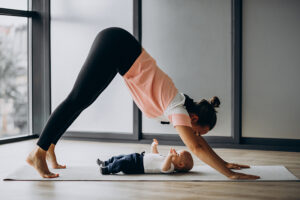Taking Root: A Step-by-Step Guide to Mastering Vrikshasana
As one of yoga’s foundational standing poses, Vrikshasana is accessible yet profoundly grounding when learned mindfully. Follow these steps to find balance:
1. Begin in Mountain Pose
Stand tall with feet together and toes pointing forward. Engage leg muscles while relaxing shoulders and hands by the side. Focus on a point to stabilize gaze. Take 5 deep breaths.

2. Shift Weight to One Foot
Inhale and transfer weight onto left foot, keeping hips squared forward. Experiment bearing 60-80% of weight on this rooted leg which will support the posture. Actively spread toes and heel down for stability.

3. Lift & Position Right Foot
Exhale, lift and bend the right knee, and grasp the ankle. Open hip while turning the knee towards right side and foot toward inner left thigh without rounding back. Place the foot directly on calf or inner thigh. Maintain grounding through left foot.

4. Find Gazing Point & Extend Arms
Inhale and extend arms overhead with palms joined. Fingers point skyward. Gaze at a focal point ahead to aid balance, coordinating breath and movement.

5. Mindful Alignment
Ensure lifted right foot remains parallel to floor. Do not sickle inward. Extend spine tall, engage core, relax shoulders away from ears with no grip in hands. Continue 5 breaths.

6. Repeat Other Side
Exhale hands down and release back to Mountain Pose. Switch foot positions and repeat posture on opposite side with control. Build endurance
for 30-60 seconds.

Modifications & Variations
Beginners – Use wall for hand or foot support. Gaze forward only. Modify range of motion safely according to ability.
Intermediate – Add pendant pose grasping big toe with peace fingers once balanced. Intensify by closing eyes once steady or raising bottom foot toward calf contact.
Advanced – Experiment with rhythmically swaying front hand or ankle side to side akin to wind blowing through branches. Nourish the deepest roots of mind-body connection. This graceful dance between earth and sky reorient us to what it means to stand tall, not just in yoga, but in our lives with resilience needed to weather difficult storms. Stand steady.
Vrikshasana (Tree Pose) Yoga Pose Instructional Video
https://www.youtube.com/watch?v=bI6-aWtPKtY
The key to stability in Vrikshasana lies not in rigid grasping but consciously distributing effort across well-connected foundations. Our breath, gaze, and attention to alignment nourish flexibility over fear for remaining centered yet adaptable to life’s breezes – like the supple yogi learning from nature’s wise teachers since ancient times.
Rooted in Tradition: The Ancient Origins of Vrikshasana
Under the leafy canopies of Indian fig trees, yogis have long stood in stillness. With one foot rooted into the earth and the other lifted skyward, they channel the steadfastness of these great giants. Arms reach up to grasp its branches in quiet contemplation as gentle breezes sway. This enduring posture, vrikshasana, is better known today as Tree Pose.
Texts dating back over 2,500 years reveal how Tree Pose has long served as a gateway to the inner stillness at yoga’s core. Scholars point to references in the Bhagavad Gita where a standing warrior symbolized resilience against life’s storms. Similarly, the ancient sage Patanjali used the metaphor of a towering tree to demonstrate unwavering discipline against distraction.
In Hatha Yoga Pradipika, a 14th century manual still studied today, Tree Pose is said to build focus and balance. Sthira sukham asanam, as they called it – steadiness and ease. Modern yoga masters agree it trains more than the body’s muscles. B.K.S Iyengar encourages students to “feel the breeze” like leaves rustling, connecting sensory experience with present awareness.
So the next time you rise with one foot rooted while the other stretches high, remember the rich history behind this pose. You are joining a timeless practice passed down through generations. With patience and care, yoga’s lessons reveal themselves through this graceful dance between earth and sky. Can you stand tall and remain unshaken?
Branching Out: The Myriad Benefits of Tree Pose
Beyond a foundational standing posture, Vrikshasana offers whole-body wellness benefits validated through scientific study and by the experience of yoga experts.
Enhancing Balance and Proprioception
Several studies confirm Tree Pose helps improve balance, proving an accessible way for seniors to prevent falls. One report published in the International Journal of Yoga Therapy showed participants averaging over 60 years of age significantly enhanced balance scores after doing Tree Pose along with other yoga postures twice a week for 8 weeks.
Many yoga instructors also observe Vrikshasana heightening body awareness and proprioception – our internal GPS giving positional feedback through nerves and tissues. As students tune inward to find equilibrium in this posture’s dance between earth and sky, the richest fruits often blossom as mindfulness ripening stable roots within.
Building Lower Body and Core Strength
Maintaining Vrikshasana demands considerable coordination, ankle stability, and core engagement to stabilize the pelvis. As North Carolina-based yoga teacher Aisha Matthews observes, “Lifting one foot off the ground while balancing on the standing leg calls leg muscles to action strengthening thighs, calves, and intrinsic foot muscles.”
Studies also confirm significant muscle activation not just in the raised leg but also the grounded one bearing more load, making this an deceivingly demanding posture for lower extremities. Tree Pose works the abs, obliques and erector spinae controlling spine alignment as well.
Relieving Stress and Enhancing Focus
It’s not just about physical gains – studies reveal practicing Tree Pose helps relieve anxiety, exhaustion and negative emotions while improving alertness. As concentration narrows towards balance, circulating stress hormones decrease while alpha and theta brain waves surge, inducing centered calm.
Bhava Ram, San Francisco yoga teacher and former monk, guides students to tap this state through steady gazing: “Choose a focal point 4-5 feet ahead to avoid strain as the eyes influence balance. Breathe smoothly while observing the continuous dance between stillness and adjustment. This trains us to find equilibrium amid life’s storms.”
Weathering the Wind: Overcoming Vrikshasana Challenges
Navigating the Challenges of Vrikshasana
Vrikshasana, or Tree Pose, may seem simple, but it’s not always easy to maintain balance and focus. Let’s explore some common challenges you might face and practical tips to overcome them, drawing insights from seasoned yoga practitioners and physical therapists.
Q1: Why do I keep losing my balance in Vrikshasana?
A1: Tips for Balance Improvement
– Focus on a Fixed Point: Choose a spot in front of you and keep your gaze steady. This technique, known as ‘Drishti,’ helps maintain balance.
– Foot Placement: Place your foot on your inner thigh or lower leg, but never on the knee. Press your foot and leg together for stability.
– Body Alignment: Keep your spine straight and tall. Imagine a string pulling you up from the top of your head.
– Breathing awareness: Keep your breathing deep and long to hold the pose for longer duration.
Q2: How can I avoid common yoga mistakes in Tree Pose?
A2: Yoga Safety Tips
– Don’t Rush: Move into the pose slowly and mindfully to maintain control.
– Listen to Your Body: If you feel pain, especially in the knees, adjust your pose or take a break.
– Use Props: If you’re struggling, use a wall or chair for support until you build more strength and balance.
Q3: How can I strengthen my muscles for better Vrikshasana practice?
A3: Balance Improvement Exercises
– Leg Strength: Simple squats and lunges can strengthen your legs.
– Core Exercises: A strong core is essential for balance. Try planks and abdominal exercises.
– Practice Balance: Try standing on one foot while doing everyday tasks like brushing your teeth.
Q4: What should I do if I keep falling out of the pose?
A4: Embrace the Wobble
– Be Patient: It’s okay to wobble or fall. Yoga is a journey, not a destination.
– Breathe: Focus on your breath. It helps in maintaining balance and calmness.
– Try Again: Each time you try, you build more strength and stability.
Growing Stronger with Every Practice
Remember, encountering challenges in Vrikshasana is a part of the learning process. Each time you wobble and regain your balance, you’re not just improving your physical stability, but also training your mind to stay calm and focused amidst life’s challenges. Keep practicing, stay patient, and watch your Vrikshasana, and overall well-being, flourish.
Finding Your Forest: Embracing Support in Your Vrikshasana Journey
Discover a World of Yoga Support
Embarking on your yoga journey, especially mastering Vrikshasana, is exciting and sometimes challenging. But don’t worry, there’s plenty of support out there. Have you ever thought about joining a yoga community? It’s like having a family of fellow yoga enthusiasts. They share tips, experiences, and lots of encouragement.
Learn from the Comfort of Your Home with Online Yoga Classes
Online yoga classes are a fantastic way to learn. You can practice any time that suits you, right from your living room. These classes cater to all levels, from yoga newbies to seasoned practitioners. And guess what? You’ll be nailing that Vrikshasana pose in no time, all thanks to these accessible lessons.
Personalized Yoga Training Just for You
Ever thought about using a yoga app? These apps are like having a personal yoga teacher in your pocket. They’re great for learning Vrikshasana at your own pace. Plus, many of these apps have cool features like AI posture correction to make sure you’re doing the pose just right.
Real Stories, Real Success
Hearing from people who’ve benefited from these resources can be super inspiring. Take Priya from Bangalore, who said, “Joining an online yoga community changed my practice. The support and tips helped me improve my Vrikshasana.” And there’s Narayan from Mumbai, who shared, “The personalized training from my yoga app really upped my game. The posture corrections were a game-changer for me.”
Introducing FlexifyMe: Your Yoga Journey, Personalized
For a comprehensive yoga experience, check out FlexifyMe(Mentalstress). It’s a platform that brings together certified trainers, AI-powered posture correction, and custom yoga plans. It’s convenient, affordable, and a great tool for anyone looking to improve their yoga practice, including mastering Vrikshasana.
Let’s Begin Your Vrikshasana Adventure!
Are you ready to dive into the world of Vrikshasana? Join our supportive online community for guidance and inspiration. And don’t forget to grab our free yoga poses guide and the downloadable Vrikshasana variations cheat sheet, available exclusively at FlexifyMe. Let’s embark on this journey together, finding balance and strength in every pose.


